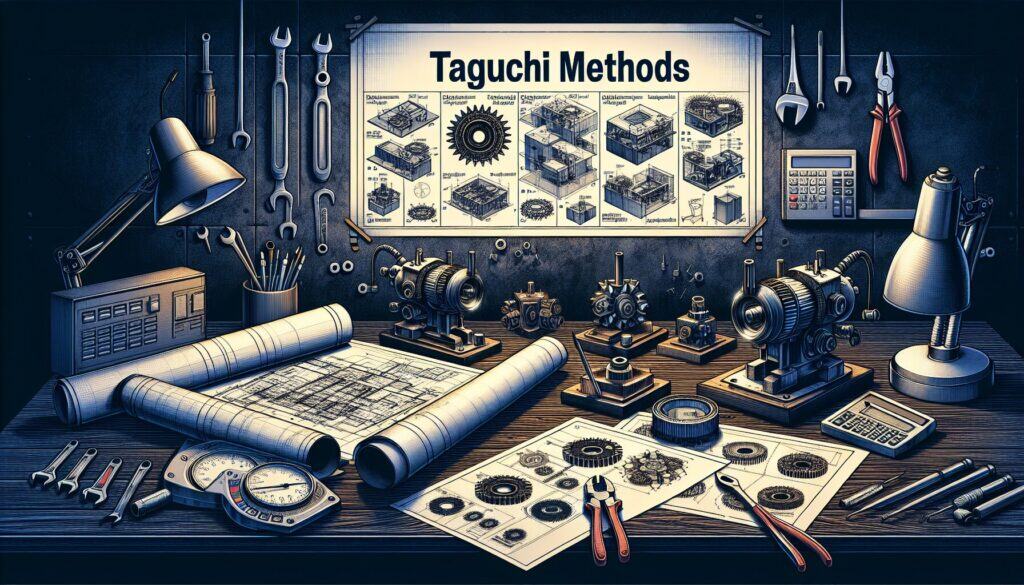Una metodologia ingegneristica incentrata sul miglioramento della qualità e sulla riduzione dei costi attraverso la progettazione di prodotti e processi robusti alle variazioni incontrollabili (fattori di disturbo).
- Metodologie: Clienti e marketing, Ideazione, Progettazione del prodotto
Metodi Taguchi (progettazione robusta)

Metodi Taguchi (progettazione robusta)
- Miglioramento continuo, Progettazione per la produzione (DfM), Progettazione per Sei Sigma (DfSS), Ottimizzazione del design, Produzione snella, Miglioramento dei processi, Garanzia di qualità, Controllo di qualità, Controllo statistico del processo (SPC)
Obiettivo:
Come si usa:
- Utilizza il disegno sperimentale statistico (ad esempio, le matrici ortogonali) per identificare i parametri ottimali di progettazione che rendono il prodotto o il processo insensibile alle variazioni di produzione, ambiente e utilizzo, riducendo così al minimo la variazione delle prestazioni.
Professionisti
- Permette di ottenere prodotti di qualità superiore con costi di vita inferiori; riduce la necessità di tolleranze di produzione ristrette; si concentra sul raggiungimento costante delle prestazioni target.
Contro
- L'implementazione può essere complessa e richiede conoscenze statistiche; gli esperimenti possono essere lunghi e costosi se non pianificati in modo efficiente; in alcuni casi possono semplificare eccessivamente interazioni complesse.
Categorie:
- Ingegneria, Produzione, Qualità
Ideale per:
- Progettare prodotti e processi che siano minimamente influenzati da fattori di disturbo incontrollabili, per ottenere prestazioni costanti.
Taguchi Methods, particularly in robust design, find significant applications across various industries such as automotive, electronics, consumer products, and manufacturing, where the goal is to improve product resilience against fluctuations in material properties, environmental conditions, or user interactions. This methodology is especially relevant during the product development phase, where initial prototypes are tested using statistical techniques to analyze how different design parameters affect performance. Teams composed of design engineers, quality assurance professionals, and data analysts often collaborate in this process, ensuring that multiple perspectives contribute to a well-rounded approach. For example, in the automotive sector, Taguchi Methods can be utilized to assess aspects such as suspension system performance under various road conditions, allowing manufacturers to design vehicles that provide a smooth ride regardless of external disturbances. The use of orthogonal arrays in experiments allows teams to efficiently study many factors simultaneously, significantly speeding up the optimization process. Furthermore, implementing Taguchi Techniques minimizes the requirement for extensive physical testing since statistical results can often predict how changes will affect product performance, resulting in reduced development time and costs. By integrating customer feedback early in the design process, companies are better positioned to identify and address specific needs, leading to high satisfaction rates and lower warranty claims once the product is launched. These benefits contribute not only to superior product quality but also to long-term savings associated with maintenance and customer service, as robust designs are more likely to remain reliable over their lifecycle.
Fasi chiave di questa metodologia
- Identify the target quality characteristics for the product or process.
- Determine the noise factors affecting performance.
- Select appropriate orthogonal arrays for experimental design.
- Conduct experiments to evaluate the effects of design parameters on performance.
- Analyze experimental results to identify optimal levels of design parameters.
- Conduct confirmation experiments to validate optimal settings.
- Implement improvements based on findings.
- Monitor performance to ensure consistency and robustness post-implementation.
Suggerimenti per i professionisti
- Utilize advanced Taguchi orthogonal arrays to systematically explore multi-factor interactions and identify robust settings that can mitigate the impact of noise.
- Integrate response surface methodologies post-Taguchi analysis to refine the optimal design parameters identified, ensuring enhanced performance stability across varying conditions.
- Conduct regular sensitivity analyses on the identified optimal settings to anticipate how changes in noise factors could impact performance, enabling proactive design adjustments.
Leggere e confrontare diverse metodologie, raccomandiamo il
> Ampio archivio di metodologie <
insieme ad altre 400 metodologie.
I vostri commenti su questa metodologia o ulteriori informazioni sono benvenuti su sezione commenti qui sotto ↓ , così come tutte le idee o i link relativi all'ingegneria.
Contesto storico
1949
1950
1950
1960
1960
1960
1960
1940
1950
1950
1958
1960
1960
1960
1960
(se la data non è nota o non è rilevante, ad esempio "meccanica dei fluidi", viene fornita una stima approssimativa della sua notevole comparsa)















Post correlati
Simulazione di Monte Carlo
Test basati su modelli
Controllo del modello
Ricerca con metodi misti
A prova di errore (Poka-Yoke)
Test del profilo di missione